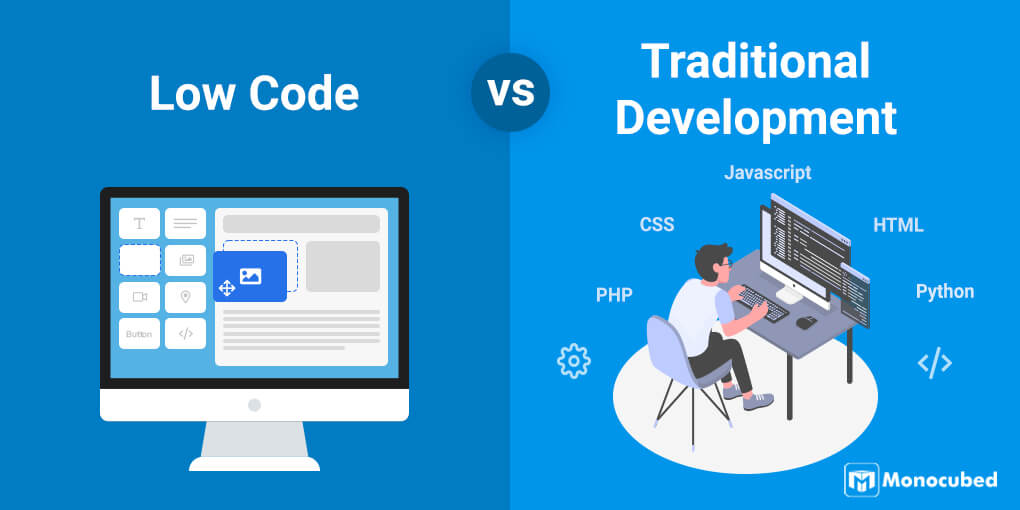Great Advice For Picking Low-Code Platform Examples
Great Advice For Picking Low-Code Platform Examples
Blog Article
Benefits Of Low-Code Application Development In Terms Of Integration Capabilities
Low-code application development offers significant advantages in the area of integration capabilities, which are vital for developing applications that can seamlessly integrate with diverse platforms and services. Here are the benefits of pre-built APIs and connectors:
Wide Selection of Connectors. Low-code systems typically include an array of pre-built connections to enterprise systems that are popular (e.g. cloud services, databases, CRM). This makes it easier for connecting these systems.
API Integration: A lot of platforms offer out-of-the box API integration features. Developers can easily connect with external data and services.
User-Friendliness
Drag-and–Drop Interfaces: Many integration tasks can be easily performed using drag-and–drop interfaces. This makes it possible for developers and others who are not developers to create complex systems without the need for extensive programming.
Visual Workflow Creators: The graphic tools that are used to design workflows and data flows makes users easier to comprehend the integration process.
Standardized Integration Methods:
SOAP and restful services that support web services common protocols such as REST or SOAP allows integration with a a large variety of software and systems.
OData Other Standards: The support for standards like OData allows transfer and manipulation of data across different platforms and applications.
Real-Time Data Synchronization:
Real-time Integrations: Low-code devices can handle real-time data synchronization between applications and systems, assuring that data is always up-to-date and uniform across the entire organization.
Event-Driven Architecture: A few platforms can support event-driven architectures. which allow applications to react to events in real-time. This is crucial for interactive and dynamic apps.
Legacy System Integration:
Low-code platforms offer a variety of tools to connect with existing systems. They enable organizations to modernize IT without having to overhaul their existing systems.
Data Migration Tools: These built-in tools for data migration make it easier to transfer from old systems to software developed on low-code platforms.
Integration of third-party services:
Cloud Services Integration: The seamless integration of cloud services, like AWS Azure, Google Cloud, allows for easy deployment and scaling up of applications.
Integration of Business Applications Lowcode platforms can be used to integrate various business applications like Salesforce, SAP, Microsoft Dynamics etc. to create a seamless workflow between different business functions.
Simplified Data Processing
Unified Data Models: Certain lowcode platforms provide unified coding models which simplify the management of data and integration, as well as synchronization across various platforms.
Data connectors: Data connectors that are preconfigured to provide easy access and manipulation to data from multiple sources.
Security and Compliance
Secure Integrations: Low-code systems ensure that integrations adhere to security standards and protocols, helping to secure data both during transport and in storage.
Compliance Features: These platform often include features which make sure that integrations comply with regulatory requirements, such as GDPR and HIPAA. This can provide peace of mind for businesses that handle sensitive data.
Extensibility:
Low-code platforms can often accommodate complicated integration requirements by incorporating custom scripts or code. They provide flexibility, but without sacrificing their ease of use.
Plug-in Ecosystem A collection of plugins and extensions that can enhance the integration capabilities, allowing users to add additional functions as they need.
Low-code platforms can be a useful device to build interconnected, robust and scalable applications. They simplify the process of connecting disparate system, improve the flow of data and enable businesses to adopt new technologies while using existing ones. Have a look at the recommended Low-code Platform for application development for website tips including cross platform mobile dev, developing mobile apps, cross platform mobile app development, develop mobile application, app dev platform, rapid applications, push notifications android, cross platform mobile app development, develop web app, cross platform app development and more.
Benefits Of Developing Applications Using Low-Code In Terms Of Cost-Efficiency
Low-code application development offers numerous advantages when it comes to cost-efficiency, making it an attractive option for businesses looking to maximize their development budgets while still delivering top-quality software. Here are the key advantages: Lower development costs:
A lower code platform eliminates the need for long manual code. This saves time and effort of developers in developing applications. It also means lower cost of labor.
We require less developers: Development that is low-code requires shorter time, and it is easier. This means that less developers are needed. This will significantly cut down on the cost of hiring and staffing.
Faster time to market:
Accelerated cycle of development: Visual tools for development as well as pre-built parts provided by platforms with low-code enable rapid design of applications, which allows firms to bring their products to market faster. This can translate into faster revenue generation and a better position in the marketplace.
Rapid Prototyping. Businesses can rapidly test and create prototypes. This helps reduce time during the development phase and allows for rapid iterations based on feedback from users.
Reduce Maintenance Costs
Due to their modularity and common components, applications developed on low-code platforms are more simple to maintain. This reduces the cost of maintenance on a regular basis.
Automated Updates Many low-code platforms can be adapted to managing patches and updates in a manner that's as secure as well as timely. This means that there is no requirement for manual intervention.
Efficient Resource Utilization:
Platform contributions that are low-code let business users as well as other non-developers to participate in the process of creating. This democratization allows businesses to make use of the expertise of many employees and reduce the dependence on high-paying programmers.
Improved Utilization Of IT Resources: IT teams can concentrate on strategic initiatives rather than being stymied by routine development tasks, increasing efficiency and productivity overall.
Scalable Pricing Models:
Subscription-Based Pricing: A lot of lowcode platforms offer flexible, subscription-based pricing models that grow with usage. This allows businesses to be able to align their spending with the actual demands and growth while avoiding large upfront costs.
Pay-Asss-You-Go Option: Some platforms offer pay-ass-you-go options that ensure that businesses only pay for the time they make use of resources. This is particularly helpful for startups and smaller businesses with limited budgets.
Reduction in Third-Party Software Costs:
Built-in Functionalities : Low-code platforms usually comes with built-in functionality and integrations that reduce the need for extra third-party software, tools and licenses.
Pre-Built Integrations: Having pre-built intiations with popular systems and services minimizes the need for custom-designed development. Savings on both time as well as money.
Increased ROI
More efficient return on investment (ROI) Through the combination of rapid development, less expense and a quicker time to the market, businesses are able to achieve a faster ROI for their applications.
Improved agility: Companies can adapt quickly to changes on the market or customer demands, which allows businesses to remain relevant and benefit from new opportunities.
Training costs are less:
User-Friendly Interfaces: Low code platforms are user-friendly and have simple interfaces that reduce the time required to learn.
Accessible Resources: Many low code platforms provide complete training materials and tutorials and also community assistance. These resources reduce the need for formal instruction and its associated expenses.
Collaboration is streamlined:
Collaboration Tools: Integrated collaboration tools improve communication and coordination within teams, which results in better processes for development, and less overhead.
Unified Development Environment. A single, unified software development environment could streamline processes and decrease the cost and complexity of managing multiple platforms and tools.
Overall, the cost-effectiveness of low-code application development stems in its ability to lower the cost of development and maintenance and speed up time to market, maximize utilization of resources, as well as provide flexibility in pricing. This combination of factors offers companies significant financial advantages, making Low-code an attractive choice for companies looking to maximize development budgets, yet still creating robust and scalable applications. Take a look at the recommended look at this on Enterprise application development with Low-code Platform for blog examples including rad development, build with docker, app platforms, build with docker, ms azure sql, push notifications, cross platform mobile development, cross platform mobile dev, low code development platforms, cross platform app dev and more.
Community And Support From The Vendor Are Two Advantages Of Low Code Development For Applications.
Low-code development platforms offer significant advantages in terms of support from vendors and the community. These are crucial for successful implementations, ongoing maintenance, and continuous improvement. Support from the Vendor
Comprehensive Technical Support:
Dedicated Support Teams A lot of low-code platforms have special support teams that are able to assist with technical issues, problem-solving and provide guidance. This will ensure that any issues are swiftly addressed.
Help is accessible 24/7: A lot of vendors offer 24/7 support that can be especially helpful for businesses operating in multiple time zones.
Onboarding and Training:
Structured Training: A number of vendors offer structured training, including webinars, tutorials and certification courses to assist users to quickly get familiar with the platform.
Personalized Onboarding Many vendors offer individualized services to assist their new customers get onboard effectively and customize it to their requirements.
Updates and Enhancements, Regularly, and Enhancements:
Continuous Improvement: Low-code platform vendors generally release periodic updates that include new features, performance improvements as well as security patches, ensuring that the platform stays cutting-edge and safe.
Feedback Integration: Vendors frequently integrate feedback from users into their development processes, ensuring that their platform is constantly evolving to meet the changing needs of its users.
Comprehensive Documentation:
Documentation: Comprehensive documentation is offered for all products. It covers everything from the basics to advanced customization. This can help users find solutions for themselves.
API References: The detailed API documentation helps developers integrate the low-code platform into other systems and tailor their applications to be effective.
Professional Consulting Services
Expert Consultation : Vendors offer consulting services, such as the design of architectures and complicated implementations. They provide this service in order to make sure that their users are able benefit from the platform.
Custom Development Services Certain companies offer custom development services in order to build specific integrations and features that aren't available in the standard.
Community Support
Active User Community:
Forums and Discussion Boards Numerous low-code platforms have lively online communities that allow users to discuss issues, ask questions, and share solutions, and work together on best practices.
User Groups and Meetings: Both local and virtual meetings and groups of users provide opportunities to learn about, network, and share experiences with other users.
Knowledge Sharing and Collaboration
Community-Contributed Resources: Users often share templates, modules, and extensions that they have developed, which can be reused or adapted by others, accelerating development and innovation.
Crowdsourced Solutions: The collective wisdom, experience and expertise of a community may be an effective tool for solving problems and coming up with creative solutions.
Learning and Development
Community-led training: Many communities provide webinars, workshops, and training sessions led by experienced users.
Online Tutorials: Community members contribute and share numerous online tutorials, how-tos, and tutorials. These resources are accessible to all.
Feedback and Influence
Product Feedback Channels. Forums for community members usually have channels that allow you to provide feedback to the manufacturer. The feedback you provide can affect the design and development of features.
Beta Testing Programs. Members of the community who are active can take part in beta-testing programs. They will be given an early introduction to the new features of the platform and the chance to influence the future of the platform.
Recognition and encouragement:
Community Recognition Programs - A lot of vendors have recognition programs to recognize the efforts of the active members of their communities, including MVP (Most Valuable Professionals) programs.
Peer Support : Members of the community give support to each other, sharing their experience and offering guidance. They create a collaborative and supportive environment by sharing their knowledge.
Overall, a strong vendor's support and an active, vibrant community offer a robust support system for low-code app development. This ensures that users have the knowledge, resources and collaboration opportunities, they need to develop and successfully deploy their applications.